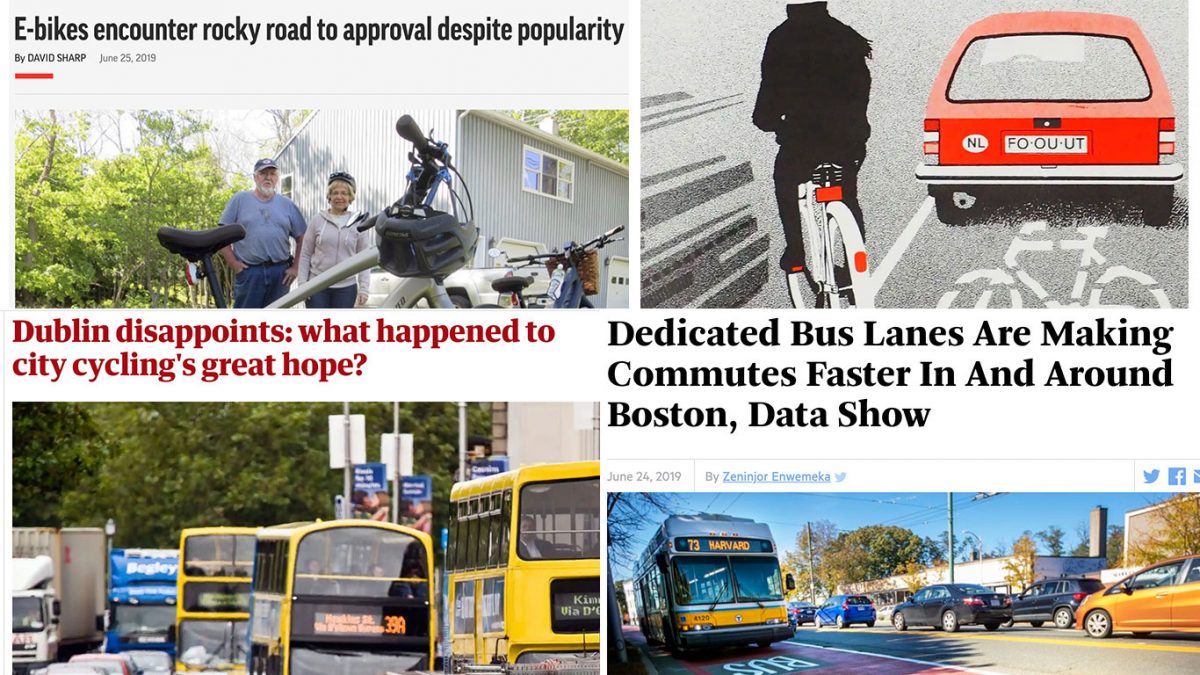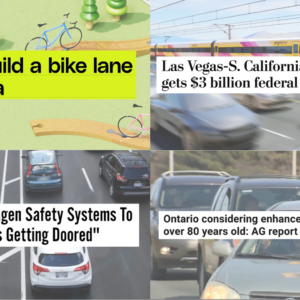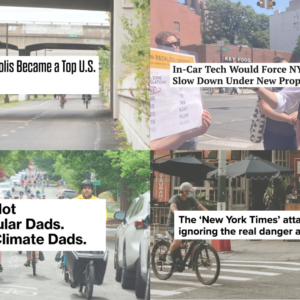This week’s Monday Roundup is sponsored by Rack Attack.
Here are the most noteworthy stories we came across in the past seven days…
Danish secrets revealed: A new resource launched by the Cycling Embassy of Denmark and Union Cycliste Internationale is a treasure map and advocacy arsenal of Danish solutions to cycling and urban planning challenges.
Carfree politics: A shift to the right in Madrid’s politics has produced ominous clouds over the city’s recent ban on cars in its city center. Clean air and healthy cities shouldn’t be partisan!
It works in Boston: Given that Portland is doing essentially the same thing, the success of Boston’s bus-only lanes is worth paying attention to.
Bread by bike: Portland has its share of bike-based businesses; but I’ve yet to hear about anyone like this Oakland baker who makes and then takes bread to customers on two-wheels.
Dublin’s downfall: There might be lessons for Portland in this story about how Dublin’s once lofty biking goals and plans have stymied since a 2013 economic downturn and a few controversial projects.
Advertisement
Propaganda for the win: Anti-car sentiment isn’t just a given in Dutch culture, it was nurtured in part by 50 years of activism stoked by artwork and posters that helped people visualize the terrible consequences of car abuse.
Kids know: About the only unbiased, truthful source of information we can rely on these days is our kids. Thankfully The War on Cars podcast asked a few of them how their lives are constrained by car-dominated streets and cities.
Car parking isn’t green: This same article about Seattle’s massive new parking garages could have been written about Portland.
E-bike regs not keeping up: We finally find a way to get more Americans on bikes and now outdated regulations are keeping people from using them to their full potential. America. Sigh.
Tweet of the Week: Archival footage of altercation between a driver and safe streets activists in Amsterdam:
https://twitter.com/notjustbikes/status/1144351266144997377
— Jonathan Maus: (503) 706-8804, @jonathan_maus on Twitter and jonathan@bikeportland.org
Never miss a story. Sign-up for the daily BP Headlines email.
BikePortland needs your support.







Thanks for reading.
BikePortland has served this community with independent community journalism since 2005. We rely on subscriptions from readers like you to survive. Your financial support is vital in keeping this valuable resource alive and well.
Please subscribe today to strengthen and expand our work.
On the “kids know” topic. My 9 and 12 year old daughters surprised me by saying they would prefer to live in a suburb like their cousins that live in Hillsboro because the cul de sac they live on has few cars on it so it is safer to ride bikes and play in.
https://www.citylab.com/design/2011/09/street-grids/124/
“you’re safer if you never leave your cul-de-sac”
It is strange to see bus-only lanes sit mostly empty, but probably even stranger that “more buses” is rarely discussed as the solution.
Also, while researching a different topic, I learned that this is just recreating history: besides the dedicated right-of-way, Portland’s original streetcars were exempt from traffic controls. Talk about signal priority, they had transit lanes with Idaho Stop!
That’s the common refrain from drivers – that the individual gas tax somehow accounts for their “fair share” of transportation funding. In Oregon, I think it is about 18% of the ODOT budget with auto registrations coming in about 18-19%. Honestly I have not checked since 2018.
The rest of ODOT funding is primarily industry fees and bond measures.
So any variability in individual funding for a car owning cyclist is within that 18%. Assuming a 10000 mile per year driving habit at 25mpg, the driver would pay $136 is state gas tax. Now that’s just for ODOT roads and we know the local roads have a different funding mechanism…but the next time a driver lectures you about how much they pay in state gas tax, throw that number out at them.
ODOT is largely funded by gas taxes, vehicle fees, and federal sources. There are few random other inputs, but those are the big ones.
That is not true. We have had this conversation before in comments sections and I have included links to ODOT budget pages. You are spreading false information.
Sigh. I said “ODOT is largely funded by gas taxes, vehicle fees, and federal sources.”
How is the following in any way different from what I said?
=====
The Oregon Department of Transportation will collect just over $5.3 billion in total revenue during the 2017–2019 biennium.
23 percent from the federal government.
77 percent from state sources– the state fuels tax, taxes on heavy trucks, driver and motor vehicle fees, and bond proceeds and Certificates of Participation.
ODOT also receives funding for specific purposes from cigarette tax revenues, lottery funds, and a variety of transportation-related permits and fees.
From https://www.oregon.gov/ODOT/About/Pages/Transportation-Funding.aspx
Sigh.
You state “ODOT is largely funded by gas taxes, vehicle fees, and federal sources” but cannot show the total percentage of ODOT’s funding from those three sources, even to the nearest 10%. I followed your link, Federal funding is listed as 23%, the others have no numbers, so how do you know funding is largely from the three sources that you state?
You might be right, I don’t know. If you have inside information, I’d love to know, as it is hard to find these details. If you don’t have more information, then why are you making these unsupported claims?
Please click the link I posted, expand the “Sources of Transportation Funding” section, and read it. I’ll wait.
I read it again. It still doesn’t back up your claim. It mentions lots of funding sources, and very little detail about what proportion of ODOT funding each source contributes. You want me to cut and paste the whole thing here? Quote me the part that shows what you wrote.
You made a claim, you can’t prove it. Maybe you feel foolish or are trying to save face. I have no interest in being right or wrong, or looking good or bad. I’d like to know more details of ODOT funding, and I’d like not to have misinformation passed around.
I will piggyback onto Jim’s request. I have been trying to get to the bottom of this ever since ODOT’s angry response to the BTA’s ill-considered infographic caused the BTA to in my view foolishly retract it. ODOT’s claim then (which I found completely unsatisfying) was that bonds *were* user fees, which allowed them to assert that in our state—unlike all or most others—the majority of funds required to build and maintain our roads came directly from users of those roads. I was never able to get to the bottom of this, but not for lack of trying.
https://bikeportland.org/2013/11/12/do-bikes-get-a-free-ride-advocates-infographic-shows-why-not-96950
And some links embedded in that discussion back then:
https://bikeportland.org/2013/11/12/do-bikes-get-a-free-ride-advocates-infographic-shows-why-not-96950#comment-4478912
See idlebyte’s analysis below. My link does describe what some of the 8% goes for, largely not road building.
There you go again. Everyone else is talking about commuting drivers and you seem to want to conflate them with commercial drivers. “The rest of ODOT funding is primarily industry fees and bond measures.”
Industry fees being something a commuting driver contributes to just as much as a commuting cyclist so their gas tax is still only paying $136 more.
Let me clearly state: Commuters do not pay for the entirety of the highway system.
my estimate was based on the assumption of 10k miles and 25mpg.
Your mileage may vary 🙂
Thanks Idlebyte.
So, “gas taxes, vehicle fees, and federal sources” make up about 60%. I guess you could call that “largely funded”. It is still frustrating that car drivers are subsidized by non-car drivers.
When idlebytes added it up, they got 92-93%; why do you only get 60%? Which of those items do you count as being from “non-drivers”?
Related and relevant: Portland’s original streetcars also had a speed limit that was equivalent to a horse’s walking speed. (TBH I feel like that law’s still in place with the streetcars today.)
Source: 60’s era textbook for kids I found while researching for my Portland history unit in 2011. I can dig up the scans if anyone’s interested!
I think that the Expedia garage is symptomatic of the way that urban planning is done in most of North America and a good part of the rest of the world. The assumption, when developing building codes and approving developments, is that people are going to drive there, so parking must be provided, and in some cases the developer has to pay for certain road works. If the assumption is that people must use public transit or bicycle, I see no reason why the developer can’t kick in for the non-automobile infrastructure. For example, in Seattle, if Amazon’s and Expedia’s HQs aren’t going to be serviced by light rail for 16 years because of a shortage of public funds, why can’t they be required to pay for the necessary infrastructure as part of their development plans. After all they got a butt load of cash from the tax cut last year.
fwiw, the expedia campus in seattle includes a major renovation of the elliott bay trail that connects neighborhoods to downtown. And despite the light rail not running directly to their basement or something, the majority of the amazon buildings are a short walk from the existing light rail stations downtown. Of course, the eilliott bay trail was already there before the expedia construction and amazon employees have a culture of looking down their noses at transit and taking uber rides home instead. These companies have done a lot for making seattle a less livable city in many regards and the parking garage in question is an example of that.
Those dutch posters are incredible. I want to print some up and put them around town. Maybe in spots where there have been bicycle/pedestrian fatalities.
Love the one with the citizens beating the cars with hammers. Wish I could read dutch though so I would know what it says. I having always thought that the first step to phasing out cars is a public relations campaign to make the public view automobiles with sadness and contempt.
I listened to the war on cars podcast. Thanks to bike Portland for letting me know. It was one of their best episodes.
Ranking the most bike friendly cities on the planet: As suspected, most are in Europe. Two are in Canada. None in the Land of the Free. Old news?
https://www.wired.com/story/most-bike-friendly-cities-2019-copenhagenize-design-index/
And this considering that the list isn’t even particularly accurate in my opinion. There should be WAY more Dutch cities on that list, and Amsterdam is nowhere near being the top cycling city in the Netherlands. Of course Cph is also consistently ranked #1 on this, which I also disagree it. It is fantastic for cycling, compared to most of the rest of the world, and is also my favorite city of all (except for cycling), but I do not agree with the placement. Most Dutch cities where I’ve ridden a bike in easily top Cph for many reasons.
Me too I can probably help with this. I added up all the sources of ODOTs funding from 2011-2019 using two of their budgets and here are the percentages I came up with.
SOURCES Percent
Motor Fuels Taxes 22.55%
Federal Funds 22.80%
Weight-Mile Taxes 12.46%
Driver and Vehicle Licenses 14.92%
Transportation License & Fees 1.99%
Transfers To ODOT 2.49%
General Fund 0.31%
Lottery Funds 2.01%
Bond COP and Refunds Proceeds 17.30%
Sales and Charges for Services 1.32%
All Other Revenue 1.85%
So based on HKs categories I believe it comes to ~23% Federal, 70% state fuels tax, taxes on heavy trucks, driver and motor vehicle fees, and bond proceeds, and 8% other sources.
I calculated these percentages using the sources table on page 8 of the following documents.
http://www.oregon.gov/ODOT/About/Budget/ODOT%202015-2017%20LAB%20Program%20Budget.pdf
https://www.oregon.gov/ODOT/About/Budget/ODOT%202017-2019%20LAB%20Program%20Budget.pdf
“Bond COP and Refunds Proceeds 17.30%”
So am I right that you agree with ODOT that bonds are properly considered a user fee, analogous to gas taxes; in other words that only people who own motor vehicles repay bonds?
I have not wrapped my head around how bonds work, but this implication (from ODOT) never was intuitive to me.
Not sure who the you is in that but I’ll weigh in anyway. I just used ODOTs description and added up the categories HK listed above. Based on the fact that over that same period 27% of ODOTs expenditures were towards debt service I assume they pay for those bonds under that line item. Which would imply that bonds are paid for at the same percentages as our sources. The funny part being that we paid more towards debt then the bonds we took out in the same period. 3.3 billion in bonds collected and 4.1 billion in debts paid.
I was asking you. And thank you.
“I assume they pay for those bonds under that line item”
They? I think you mean us – the public – no?
These monies which ODOT oversees come from various streams, as your analysis shows, but I wouldn’t consider any of it as originating within ODOT.
“27% of ODOTs expenditures were towards debt service”
Yeah, that is an enormous and parallel problem right there. I think it is worth emphasizing that those 27% aren’t building a foot of road or filling a single pothole, but all going into the pockets of usurious bankers.
Jonathan, can we get someone to come here and explain bonds to us? Specifically in relation to ODOT? I think there are some poorly understood shenanigans going on here that deserve more daylight than they have so far received.
“I wouldn’t consider any of it as originating within ODOT.” Why would you even think I was suggesting that? Especially when I broke down all the sources of their budget earlier.
Anyway their budget also includes an explanation of the bond process if you want to learn more. Starts at page 115 it doesn’t include details about their shenanigans but it’s a good place to start.
Maybe to avoid arguments about people paying for things indirectly, you could change “own motor vehicles” to “use motor vehicles”.
“use motor vehicles”
It’s against the rules on this blog to compare car use with car ownership. As long as you use a car but do not own one (e.g. are carfree) all negative karma is erased and your skin glows.
Sorry, rookie error.
So that’s why my skin glows. And to think that for all these years I thought it was from my work at the Laboratory for Energy-Related Health Research, aka the Radiation Biology Lab, where radioactive strontium was fed to beagles in hopes of figuring out what all those above-ground A-bomb tests were going to do to us. (We didn’t solve it, but did create a superfund site.)
Ah. I always thought you got bit by a radioactive spider. I guess I was close.